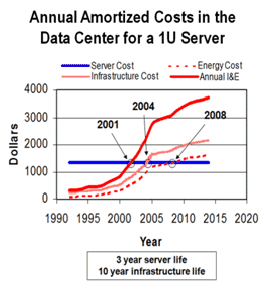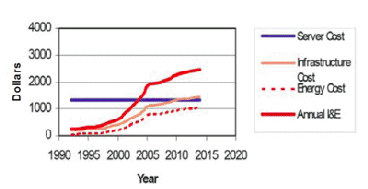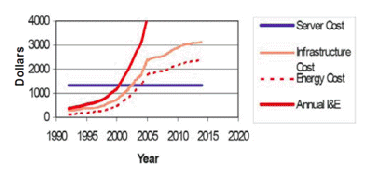Part 2—"Why is Energy Efficiency Important?"
This second article explains why energy efficiency is vitally important in today's economic climate.
Figure 1 shows a graph of the annual amortized cost of a 1U server plotted against datacenter infrastructure costs and power costs. In 2001, the sum of infrastructure and energy costs was equal to the cost of a 1U server. In 2004, the infrastructure cost alone was equal to the cost of the server. In 2008, just the energy cost was equal to the cost of a server. These energy costs are numbers that all IT staff should be aware of when calculating TCO. Yet, most companies do not have ability to provide specifics for their company, because they are still living in the 1990s when infrastructure and energy costs were not really significant.
Figure 1 - Christian Belady Feb '07 Electronics Cooling Magazine
https://www.electronics-cooling.com/articles/2007/feb/a3/
Obstacles to the Adoption of PUE
Our observation is that companies are slow to adopt PUE. Why? As you improve the efficiency of your datacenter, it will actually be more difficult to identify opportunities to save energy. The interrelationships between systems make analysis more complex, and require you to look at the problem in a holistic way. This provokes the interesting question of how to the approach the problem of energy efficiency in the datacenter. Can you see the holistic view, and tell whether your energy efficiency changes work?
From the experience Microsoft gained during presentations at industry events, the number of people using PUE has been increasing. However, it is still an amazingly low proportion for something that we believe every datacenter operator should use in order to understand the efficiency of their datacenter operations.
What are the obstacles? We believe they are:
Fear of the new
Are datacenter managers frightened of a new metric? How do they know whether the number that they calculate for their datacenter is good or bad? Maybe that is why the early adopters have been those people willing to take risks to discover how their datacenter is performing. IT can be a risk-averse culture that discourages change, but changes are required for efficiency. Change can be painful, and PUE tells you if the change is worth the effort in the big picture of datacenter efficiency.It's nobody's job
In some organizations, measurement is a function that straddles organizations or departments. Therefore, IT cannot successfully measure performance, or may not have access to the required information to be able to carry out the calculation or interpret the result.Wrong incentives
What are your metrics for your datacenter? Do you have any for energy efficiency? Can you negotiate between energy efficiency and SLAs? Do you base your datacenter manager bonuses on PUE improvement? Are chargebacks based on PUE improvement? When chargeback costs in the data center are based on portion of power consumed, managers are more diligent about right sizing for power and minimizing the power consumed. As a side note, much of the industry is still charging for space because result density has been the driver in server design rather than power efficiency.Don’t understand how simple it is
PUE is a simple metric, and requires only two numbers as input. The result is the ratio of power overhead for a unit of IT load. A PUE value of 2.0 means that for every watt used by equipment, another watt is used in the overheads of delivering power and removing heat.Worried about perfection
We have seen some people hesitate to take up PUE because they over-analyze the issues and strive for perfection using real-time data collection. Some people worry about whether they are (or should be) measuring PUE, DCiE (the reciprocal of PUE), or something else. Do not fall into these traps. Just get the two numbers you need.
What is a Good PUE?
When no data is available, a standard assumption is a PUE of 2.0. However, datacenters can achieve a PUE as low as 1.5 and it can be as high as 3.0. What is the difference? Look back at Figure 1 to see the cost ratios for a PUE 2.0. Figure 2 shows the cost ratios for a PUE of 1.5, and Figure 3 shows them for a PUE of 3.0.
Figure 2 - Effect of 1.5 PUE on infrastructure costs, Christian Belady, Chris Malone, “Metrics and an Infrastructure to Evaluate Data Center Efficiency” Proceedings of IPACK2007
Figure 3 - Effect of 3.0 PUE on infrastructure costs
Using the PUE value and datacenter costs for your infrastructure and IT Equipment, you can create your own graph. The authors believe this is one of the best ways to educate people, and show how important it is to get your team working together to promote awareness and provide an incentive to improve your PUE. Improving your PUE will not only improve your OPEX, but also improve your infrastructure CAPEX per critical load supported.
As you measure PUE across all your datacenters, you will be able to perform side-by-side comparisons of different facilities. As one datacenter makes an improvement, the change can be validated at another datacenter to confirm them as a best practice before rollout to all facilities. This does not mean all datacenters are expected to run at the same PUE value, but differences should be understood and long-term trends tracked. For example, two identical data centers in different locations may have different PUE values due to conditions such as weather and the specific IT equipment configurations.
In the next article in this series, you will see how you can start adopting PUE in your datacenter, and how Microsoft has benefited from its long-term use of the PUE metric.
Authors
- Mike Manos, General Manager Data Center Services
- Christian Belady, P.E., Principal Power and Cooling Architect
Comments
Anonymous
July 08, 2008
PingBack from http://techhermit.wordpress.com/2008/07/08/data-center-energy-efficiency-white-papers-produced-by-microsoft/Anonymous
April 08, 2009
As some of you know, the Environmental Sustainability team has recently created a Twitter account to


